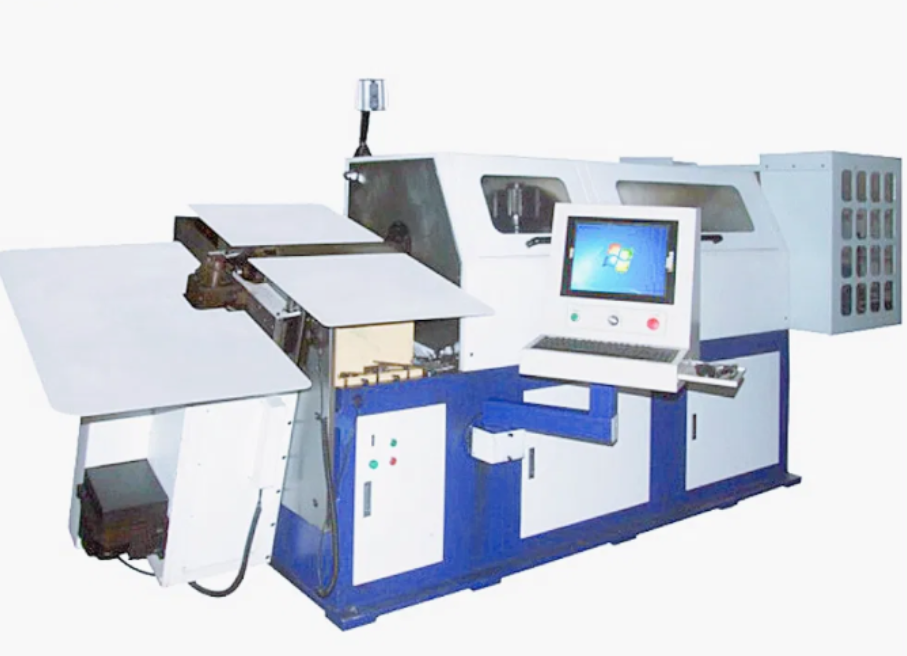
2D And 3D Wire Bending Machine
(Total 1 Products)-
Brand:XinchangMin. Order:1Place of Origin:Ningbo,ChinaCNC 2D & 3D Wire Bending Machine: The creative embodiment of metal wire formingIn the field of metal wire processing, the precise forming of complex shapes is the key to product design and functional realization. The CNC 2D & 3D Wire Bending...
2D & 3D wire bending machines are advanced automated equipment designed to shape metal wires into precise 2-dimensional and 3-dimensional forms. Widely used in manufacturing, they transform raw wire materials into various complex components, serving industries such as automotive, furniture, electronics, and construction with high efficiency and accuracy.
Working Principle
These machines operate by clamping the wire and using a combination of bending tools, rotating axes, and feeding systems. For 2D bending, the wire is shaped in a single plane through controlled angular bends and linear movements. 3D bending adds multi-axis rotation, allowing the wire to be formed in three-dimensional space. Computer numerical control (CNC) systems precisely regulate tool movements, ensuring each bend matches the pre-programmed design parameters.
Structure and Components
Key components include a wire feeding mechanism, clamping device, bending tools (dies and mandrels), multi-axis drive system, CNC controller, and safety guards. The feeding mechanism delivers wire at a steady rate, while the clamping device secures it during bending. Bending tools vary based on wire diameter and shape requirements. The multi-axis drive system enables complex movements, and the CNC controller stores and executes bending programs.
Types
Based on automation level, there are semi-automatic and fully automatic models. Semi-automatic machines require partial manual operation, while fully automatic ones handle feeding, bending, and cutting independently. By wire material, they accommodate steel, aluminum, copper, and alloy wires. Specialized types include spring-forming machines, wire frame benders, and precision micro-bending machines for fine wires.
Advantages
Firstly, they offer exceptional precision with bending tolerances as low as ±0.1mm, ensuring consistent product quality. Secondly, high production efficiency reduces labor costs compared to manual bending. Thirdly, flexibility allows quick program changes for different product designs, supporting small-batch and customized production. Fourthly, they handle various wire diameters (typically 0.5-16mm) and materials, enhancing application versatility.
Applications
In automotive industry, they produce seat frames, door handles, and cable clips. Furniture manufacturing uses them for chair frames, bed springs, and decorative wire elements. Electronics industry relies on them for sensor brackets and wire harnesses. They also create construction reinforcements, medical device components, and consumer goods like wire racks and display stands.
Development Trend
Modern machines integrate AI and IoT technologies for smart production. Advanced models feature real-time error detection, automatic parameter optimization, and remote monitoring. High-speed servo drives improve production rates, while modular designs enable quick tooling changes. Eco-friendly features like energy recovery systems and noise reduction technologies are increasingly adopted, aligning with green manufacturing standards.

2D and 3D Wire Bending Machines
Zhejiang Industrial Group Co., Ltd. is located in China (Zhoushan) National Pelagic Fishery Base, a large state-owned joint venture by Zhejiang Shenghaida Co., Ltd. (the former Zhoushan No.2 Oceanic Fishing Industry Co., Ltd.) and Maruha Nichir
Zhejiang Industrial Group Co., Ltd. is located in China (Zhoushan) National Pelagic Fishery Base, a large state-owned joint venture by Zhejiang Shenghaida Co., Ltd. (the former Zhoushan No.2 Oceanic Fishing Industry Co., Ltd.) and Maruha Nichir Zhejiang Industrial Group Co., Ltd. is located in China (Zhoushan) National Pelagic Fishery Base, a large state-owned joint venture ......
